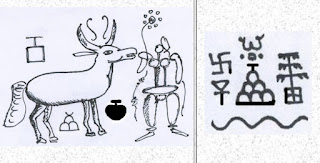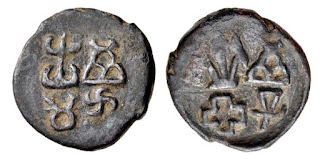Symbols are part of religious and cultural beliefs since ancient times. We come across various symbols, but when they appear on coins the whole definition, perception and its explanation changes.
Ancient Symbols on Coins
Nandipada (foot of Nandi) is an ancient Indian symbol, also called "taurine" symbol, representing a bull's hoof or the mark left by the foot of a bull on the ground. The Nandipada and the zebu bull are associated with Nandi, Lord Shiva's humped bull in Hinduism. This symbol is similar to the Brahmi letter 'ma'.
Nandiapda Symbol
Sheath of the broadsword decorated with a Nandipada.
Sanchi stupa 1, northern torna, east pillar, 1st century BC, a pair of fish tails ligatured to form a nandipada
Apollodotus, 174-165 BC, drachm, with a nandipada on the hump of the Zebu bull
Triratna. A Buddhist symbol, thought to visually represent the three jewels of Buddhism (the Buddha, the Dharma and the Sangha). The symbol is composed of a lotus flower within a circle, a diamond rod or vajra, an ananda-chakra, a trident or trishul with three branches, representing the three jewels of Buddhism. The triratna symbol is also called nandipada, by Hindus
Triratna symbol
The Triratna or "Three Jewels" symbol on a Buddha footprint, with a dharamachakra symbol on top, 1st century CE
Stupa showing Triratna symbol and Srivatsa symbol at Sanchi, Madhya Pradesh, India
Worship of Triratna, relief at Calcutta Museum.
A number of examples of this symbol appear on historical coins of Buddhist kingdoms in the Indian subcontinent. It appears on Kuninda, Indo-Parthian and Kushan coins
Silver drachm, Kuninda kingdom, 200 BC-100 AD, weight 2,2 gm
The reverse has, all the symbols, Triratna, Indradhwaj, Tree-in-railing and six arched hill
Srivatsa. The Srivatsa is an ancient symbol considered auspicious in Indian religious traditions. Srivatsa means "beloved of Sri", the goddess Lakshmi. It is a mark on the chest of Vishnu where Lakshmi resides. It is said that the tenth avtar of Vishnu, Kalki, will bear this mark on his chest. In Buddhism, the Srivatsa is depicted as a triangular swirl or an endless knot. In Chinese tradition, Buddhist prayer beads are tied at the tassels in this shape. In Jainism, Srivatsa marks the chest of the Tirthankara image. It is one of their auspicious symbol . This symbol is seen on coins of a number of Southeast Asian countries, to include Burma, Vietnam, Thailand and Indonesia
Divinity Narayana is shown with srivatsa motif on his chest on a bronze statue, weighing 9.6 Kg
Srivatsa, Kushan period, 1st-3rd century CE, Manoharapura, Mathura, currently at Lucknow State Museum
Twin fish and Srivatsa, Manohapura, Mathura, 1st-3rd century CE, Kushan period, red sandstone, National Museum, Delhi
Srivatsa, swastika and Indradhwaj, Khandagiri caves, 2nd century BC, cave 3.
Tree-in-railing . This symbol is considered to be one of the most important symbols in the Indian Numismatics. Tree-in-railing symbol is connected to Buddha, as in the ancient times, homage to Buddha was paid by worshipping Bodhi as it was in ancient custom not to depict Buddha in person. The Bodhi tree is a tree under which he sat and gained enlightenment at Buddha Gaya. The railing represents a kind of fence around the tree to prevent pilgrims from seeking cuttings.
Symbol of Tree-in railing on coins
Indra Dhwaj. Dhvaja is a banner or flag, is composed of the "Ashtamangala", the eight auspicious symbols. Indra Dwaja is considered to be the flag of Indra. Dhavajas are probably depicted since the Indus Valley Civilization seals, and later depicted on coins in ancient India. Indra is an ancient Vedic deity in Hinduism, a guardian deity in Buddhism and the king of the highest heaven called Saudharmakalpa in Jainism and is known as the "King of Gods". Indra is the most referred to deity in the Rigveda. He is the deity of the heavens, lightening, thunder, storms, rain, river and war.
Indus seal mould depicting Dhvaj in front of the unicorn
Shunga horseman 20 BC, carrying a portable Dhvaj
Indra on elephant, guarding the entrance of the 1st century BCE Buddhist cave 19 at Bhaja Caves, Maharashtra
Indradvaj symbol on ancient coins
Jayadhvaj or triangular standard depicted on Shunga dynasty coins 1st century BC.




































A Great reading
ReplyDelete